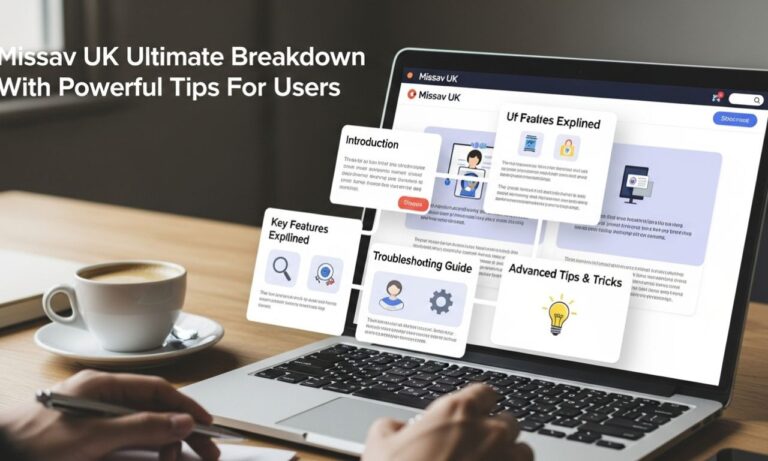
When you set out to develop Oxzep7 software, you embark on a journey that blends vision, technology and discipline. The term Oxzep7 software refers to a next-generation modular framework built to create scalable, efficient, user-centric applications.
By placing the keyword “develop Oxzep7 software” at the start of our discussion, we emphasize its central role in today’s digital landscape. In this article we’ll cover every major phase—from understanding the purpose of Oxzep7, choosing the tech stack, building architecture, to deployment, maintenance and future evolution.
Develop Oxzep7 Software: Understanding the Purpose
Before you can successfully develop Oxzep7 software you must understand why you’re doing it. What problems will this application solve? Who will use it? What gaps exist in current tools that Oxzep7 can fill? Many articles describe Oxzep7 software as a modular, cloud‐ready framework built for performance, scalability, integration and adaptability.
You should begin by defining:
-
The target audience (business teams, educational institutions, consumer users)
-
The core problem (automation, data processing, real-time analytics, workflow management)
-
The unique value proposition of your Oxzep7 build (faster onboarding, modular updates, AI support, flexible deployment)
By clarifying purpose you avoid wasted effort and ensure the product remains focused.
Develop Oxzep7 Software: Planning & Requirement Gathering
To develop Oxzep7 software in a meaningful way you need proper planning and thorough requirement gathering. The planning phase ensures that stakeholders share the same vision and the roadmap is clear. Key tasks include:
-
Conducting stakeholder workshops, defining user personas, pain‐points and workflows.
-
Prioritising features using frameworks like MoSCoW (Must, Should, Could, Won’t) so that scope stays manageable.
-
Documenting requirements with acceptance criteria, using tools like Jira or Confluence for team collaboration.
-
Estimating timelines, budget, resource capacity and technological constraints.
By doing this you create a strong foundation for the remainder of the development of your Oxzep7 software.
Develop Oxzep7 Software: Selecting the Technology Stack
When you proceed to the build phase of your mission to develop Oxzep7 software you must choose the right technology stack. Many sources highlight Python and Java as solid backend base languages for Oxzep7 projects. For instance:
-
Backend: Python 3.11+ (for rapid development, readability, rich ecosystem) or Java/Spring Boot (for enterprise‐scale robustness)
-
Frontend: React.js or Vue.js for dynamic UI; Angular for large enterprise setups
-
Database: PostgreSQL for complex queries and integrity; MySQL for lighter workloads
-
Deployment/Infrastructure: Docker, Kubernetes, AWS (or other cloud providers) for scalable containerised deployment.
By aligning your stack with your project’s goals and team skills you increase the likelihood that your Oxzep7 software will be maintainable, performant and scalable.
Develop Oxzep7 Software: Architecture & Design Principles
One of the most critical aspects when you develop Oxzep7 software is the architecture and design. Because Oxzep7 emphasises modularity, scalability and flexibility, you should adopt design patterns that support those goals. As many sources suggest, a microservices architecture is highly recommended.
Important architectural considerations include:
-
Breaking down the system into loosely coupled services, each responsible for a specific domain or function
-
Using containerisation (Docker) and orchestration (Kubernetes) to manage scalability and release cycles
-
Keeping a modular folder structure, design components that are reusable, maintainable
-
UI/UX design that focuses on user journeys, accessibility, responsiveness across devices
-
Ensuring separation of concerns, readability, and maintainability of code
These design principles will contribute heavily when you build your Oxzep7 software to ensure it handles growth, updates and future requirements.
Develop Oxzep7 Software: Implementation & Development Workflow
With planning and architecture in place, you now move into the meat of the process when you develop Oxzep7 software: implementation and workflow. Some best practices include:
-
Adopting Agile or Scrum processes: short sprints, daily stand-ups, sprint reviews, backlog grooming
-
Using version control (Git/GitHub) for source code management and collaboration
-
Writing clean, readable, well‐commented and modular code: meaningful naming, consistent style, modular components
-
Setting up virtual environments (for Python) and dependency management early
-
Leveraging code reviews, pull requests, continuous integration pipelines
-
Automating deployments and tests where possible
When you develop Oxzep7 software using this disciplined workflow you reduce technical debt, increase team productivity and allow for faster iterations and improvements.
Develop Oxzep7 Software: Testing & Quality Assurance
A cornerstone of success when you develop Oxzep7 software is comprehensive testing and quality assurance. Without good QA you risk bugs, performance issues, poor user experience and ultimately project failure. You should implement multiple layers of testing:
-
Unit testing: Each small component or function has tests to verify correctness
-
Integration testing: Services or modules interacting with each other are tested as a group
-
System testing / end-to-end testing: The entire application is tested from user viewpoint
-
User acceptance testing (UAT): Real users try the product in real‐world conditions and give feedback
In addition: -
Use automated testing tools (pytest for Python), test coverage metrics, continuous integration systems
-
Use logging, monitoring tools (for performance, errors)
-
Fix issues early rather than later
In doing so you raise the reliability of your Oxzep7 software and build trust with users and stakeholders.
Develop Oxzep7 Software: Security, Performance & Scalability
When you develop Oxzep7 software you cannot ignore the non-functional requirements: security, scalability and performance. These factors often determine whether the software will survive in real use. Security:
-
Validate and sanitise all user inputs
-
Use encryption for sensitive data, SSL/TLS for communications
-
Implement rate limiting, access controls, secure authentication and authorisation
Performance & scalability: -
Use caching (Redis, Memcached) for frequent queries
-
Use asynchronous processing or background jobs for heavy work
-
Use load balancing, autoscaling in the cloud, container orchestration
-
Monitor memory leaks, CPU usage, I/O bottlenecks
By embedding these qualities into the development of your Oxzep7 software you build a system that can withstand growth, usage spikes and evolving threats.
Develop Oxzep7 Software: Deployment & DevOps
Once your system is built and tested, the next major step is deployment—when you truly deliver your Oxzep7 software to production. Key steps include:
-
Containerising the application with Docker images, managing orchestration with Kubernetes or a similar tool
-
Setting up CI/CD pipelines (GitHub Actions, Jenkins, GitLab) for automated build/test/deploy cycles
-
Choosing the environment: On‐premises, cloud (AWS, Azure, GCP) or hybrid
-
Versioning releases, maintaining changelogs, rollback strategies
-
Monitoring production systems: logs, error tracking, real-time metrics
Proper deployment ensures your Oxzep7 software is released consistently, safely, and can scale with user demand.
Develop Oxzep7 Software: Post-Launch Maintenance & User Feedback Loop
The job does not end at launch when you develop Oxzep7 software. Post-launch maintenance and continuous improvement are critical. You should:
-
Gather user feedback via surveys, analytics, crash reports
-
Track usage metrics: user retention, performance, errors
-
Plan iterations and releases based on user needs and business priorities
-
Monitor security vulnerabilities, apply patches, update dependencies
-
Maintain documentation and team knowledge base
By nurturing this feedback loop you keep your Oxzep7 software relevant, evolving and aligned with what users truly want.
Develop Oxzep7 Software: Use Cases & Industry Applications
Understanding how to develop Oxzep7 software also means recognising where it excels. Real-world applications include:
-
Fintech: Real-time analytics, fraud detection, scalable microservices
-
Healthcare: Telemedicine dashboards, data pipelines, modular services
-
E-commerce/logistics: Inventory tracking, order processing, dynamic workflows
Because Oxzep7 emphasises modular architecture, performance, automation and integration, it fits use cases where agility, scale and customisation matter. As you develop Oxzep7 software you can tailor modules to the industry you serve, making the solution more effective and competitive.
Develop Oxzep7 Software: Common Challenges & How to Overcome Them
Of course, when you aim to develop Oxzep7 software you’ll face obstacles. Recognising them early helps you mitigate risk. Typical challenges:
-
Steep learning curve: If the team is unfamiliar with the stack, modular architecture or DevOps tools. Remedy: invest in training, pair programming, mentorship.
-
Scope creep: If the feature list expands uncontrolled. Remedy: maintain roadmap, use Agile governance, frequent prioritisation.
-
Integration complexity: Especially when connecting legacy systems or multiple services. Remedy: design clear APIs, layer abstractions, adopt middleware.
-
Performance bottlenecks: Under‐engineering for scale. Remedy: early benchmarking, monitoring, optimise architecture regularly.
-
Security vulnerabilities: Overlooking non-functional requirements. Remedy: security review cycles, code audits, threat modelling.
By planning for these challenges you increase your chances of delivering a robust, successful Oxzep7 software solution.
Develop Oxzep-7 Software: Best Practices for Success
To maximise the value of your project when you develop Oxzep-7 software, keep these best practices in mind:
-
Write modular, clean, and well‐documented code; favour readability over cleverness.
-
Maintain small, frequent releases rather than one big launch—this supports feedback and agility.
-
Automate everything possible (testing, building, deployment) to reduce manual error and speed up cadence.
-
Involve end-users early and often—design with user experience in mind.
-
Monitor the live system constantly: error logs, user behaviour, performance metrics.
-
Create an architecture that assumes change: modules can be replaced or extended without major rewrites.
-
Keep security and scalability baked in from day one, not bolted on later.
Following these will help ensure that your journey to develop Oxzep7 software yields a product that is resilient, maintainable and impactful.
Develop Oxzep-7 Software: The Future Outlook
As you contemplate building Oxzep7 software, it’s smart to look ahead. What might the future hold? Given its modular, AI-augmented and performance-driven architecture, we can expect:
-
Increased adoption of Oxzep7 frameworks across industries beyond Python scripting to mobile, edge computing, IoT.
-
Expansion of plugin ecosystems and community-driven modules to accelerate development.
-
Tighter integration with AI/ML tools, allowing predictive features, smart automation and self-optimising systems.
-
Greater emphasis on developer experience, making Oxzep7 software reachable for smaller teams and startups too.
Thus, when you develop Oxzep7 software today, you are not just building for now—you are investing in a platform that can evolve with tomorrow’s needs.
Conclusion
In summary, to develop Oxzep7 software is to align vision, technology and process in a smart, structured way. You begin by understanding the purpose, gathering requirements, choosing the right stack, designing robust architecture, implementing with discipline, and testing thoroughly. Then you deploy, maintain, gather feedback and iterate. You deal with security, scalability, user experience, and team workflow. The result is not just an application—it’s a resilient platform built for growth and adaptability.
Whether you are a solo developer, a startup team or a seasoned enterprise engineer, the journey to develop Oxzep-7 software offers a blueprint for excellence. It is a path worth taking—and one that promises to bring real value in a dynamic digital world.






